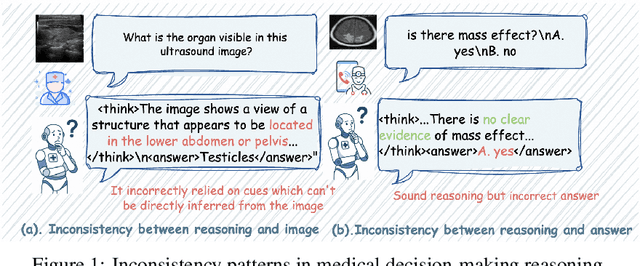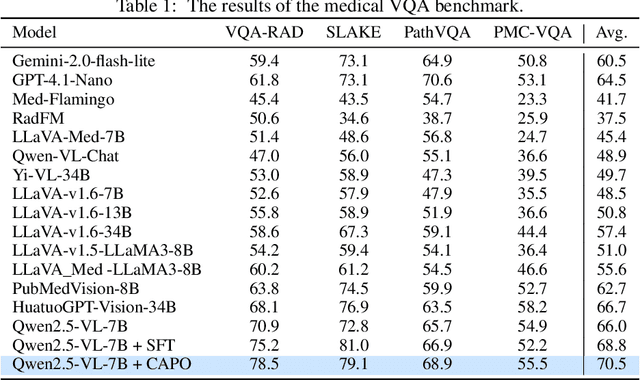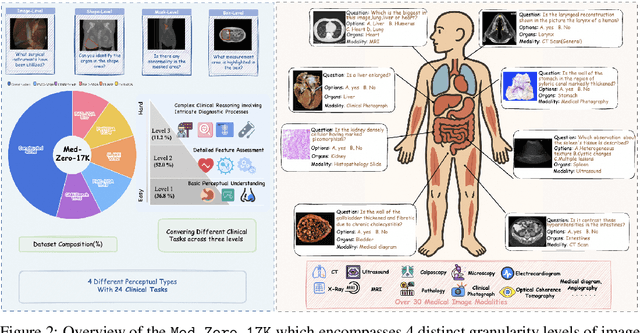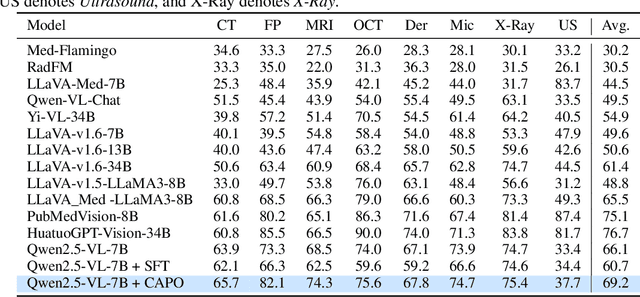Yan Zhang
Fellow, IEEE
Knowing or Guessing? Robust Medical Visual Question Answering via Joint Consistency and Contrastive Learning
Aug 26, 2025Abstract:In high-stakes medical applications, consistent answering across diverse question phrasings is essential for reliable diagnosis. However, we reveal that current Medical Vision-Language Models (Med-VLMs) exhibit concerning fragility in Medical Visual Question Answering, as their answers fluctuate significantly when faced with semantically equivalent rephrasings of medical questions. We attribute this to two limitations: (1) insufficient alignment of medical concepts, leading to divergent reasoning patterns, and (2) hidden biases in training data that prioritize syntactic shortcuts over semantic understanding. To address these challenges, we construct RoMed, a dataset built upon original VQA datasets containing 144k questions with variations spanning word-level, sentence-level, and semantic-level perturbations. When evaluating state-of-the-art (SOTA) models like LLaVA-Med on RoMed, we observe alarming performance drops (e.g., a 40\% decline in Recall) compared to original VQA benchmarks, exposing critical robustness gaps. To bridge this gap, we propose Consistency and Contrastive Learning (CCL), which integrates two key components: (1) knowledge-anchored consistency learning, aligning Med-VLMs with medical knowledge rather than shallow feature patterns, and (2) bias-aware contrastive learning, mitigating data-specific priors through discriminative representation refinement. CCL achieves SOTA performance on three popular VQA benchmarks and notably improves answer consistency by 50\% on the challenging RoMed test set, demonstrating significantly enhanced robustness. Code will be released.
SCOUT: Semi-supervised Camouflaged Object Detection by Utilizing Text and Adaptive Data Selection
Aug 25, 2025Abstract:The difficulty of pixel-level annotation has significantly hindered the development of the Camouflaged Object Detection (COD) field. To save on annotation costs, previous works leverage the semi-supervised COD framework that relies on a small number of labeled data and a large volume of unlabeled data. We argue that there is still significant room for improvement in the effective utilization of unlabeled data. To this end, we introduce a Semi-supervised Camouflaged Object Detection by Utilizing Text and Adaptive Data Selection (SCOUT). It includes an Adaptive Data Augment and Selection (ADAS) module and a Text Fusion Module (TFM). The ADSA module selects valuable data for annotation through an adversarial augment and sampling strategy. The TFM module further leverages the selected valuable data by combining camouflage-related knowledge and text-visual interaction. To adapt to this work, we build a new dataset, namely RefTextCOD. Extensive experiments show that the proposed method surpasses previous semi-supervised methods in the COD field and achieves state-of-the-art performance. Our code will be released at https://github.com/Heartfirey/SCOUT.
Gather and Trace: Rethinking Video TextVQA from an Instance-oriented Perspective
Aug 06, 2025Abstract:Video text-based visual question answering (Video TextVQA) aims to answer questions by explicitly reading and reasoning about the text involved in a video. Most works in this field follow a frame-level framework which suffers from redundant text entities and implicit relation modeling, resulting in limitations in both accuracy and efficiency. In this paper, we rethink the Video TextVQA task from an instance-oriented perspective and propose a novel model termed GAT (Gather and Trace). First, to obtain accurate reading result for each video text instance, a context-aggregated instance gathering module is designed to integrate the visual appearance, layout characteristics, and textual contents of the related entities into a unified textual representation. Then, to capture dynamic evolution of text in the video flow, an instance-focused trajectory tracing module is utilized to establish spatio-temporal relationships between instances and infer the final answer. Extensive experiments on several public Video TextVQA datasets validate the effectiveness and generalization of our framework. GAT outperforms existing Video TextVQA methods, video-language pretraining methods, and video large language models in both accuracy and inference speed. Notably, GAT surpasses the previous state-of-the-art Video TextVQA methods by 3.86\% in accuracy and achieves ten times of faster inference speed than video large language models. The source code is available at https://github.com/zhangyan-ucas/GAT.
MVAR: MultiVariate AutoRegressive Air Pollutants Forecasting Model
Jul 16, 2025Abstract:Air pollutants pose a significant threat to the environment and human health, thus forecasting accurate pollutant concentrations is essential for pollution warnings and policy-making. Existing studies predominantly focus on single-pollutant forecasting, neglecting the interactions among different pollutants and their diverse spatial responses. To address the practical needs of forecasting multivariate air pollutants, we propose MultiVariate AutoRegressive air pollutants forecasting model (MVAR), which reduces the dependency on long-time-window inputs and boosts the data utilization efficiency. We also design the Multivariate Autoregressive Training Paradigm, enabling MVAR to achieve 120-hour long-term sequential forecasting. Additionally, MVAR develops Meteorological Coupled Spatial Transformer block, enabling the flexible coupling of AI-based meteorological forecasts while learning the interactions among pollutants and their diverse spatial responses. As for the lack of standardized datasets in air pollutants forecasting, we construct a comprehensive dataset covering 6 major pollutants across 75 cities in North China from 2018 to 2023, including ERA5 reanalysis data and FuXi-2.0 forecast data. Experimental results demonstrate that the proposed model outperforms state-of-the-art methods and validate the effectiveness of the proposed architecture.
AI-Empowered Channel Generation for IoV Semantic Communications in Dynamic Conditions
Jul 02, 2025Abstract:The Internet of Vehicles (IoV) transforms the transportation ecosystem promising pervasive connectivity and data-driven approaches. Deep learning and generative Artificial Intelligence (AI) have the potential to significantly enhance the operation of applications within IoV by facilitating efficient decision-making and predictive capabilities, including intelligent navigation, vehicle safety monitoring, accident prevention, and intelligent traffic management. Nevertheless, efficiently transmitting and processing the massive volumes of data generated by the IoV in real-time remains a significant challenge, particularly in dynamic and unpredictable wireless channel conditions. To address these challenges, this paper proposes a semantic communication framework based on channel perception to improve the accuracy and efficiency of data transmission. The semantic communication model extracts and compresses the information to be transmitted. In addition, the wireless channel is estimated by using a generative diffusion model, which is employed to predict the dynamic channel states, thereby improving the quality of IoV service. In dynamic scenarios, however, the channel estimation performance may be degraded when substantially new scenarios take place, which will adversely affect user experience. To mitigate this limitation, we employ a large model to fine-tune the channel generation model to enhance its adaptability for varying scenarios. The performance and reliability of the proposed framework are evaluated on the two public datasets.
CAPO: Reinforcing Consistent Reasoning in Medical Decision-Making
Jun 15, 2025



Abstract:In medical visual question answering (Med-VQA), achieving accurate responses relies on three critical steps: precise perception of medical imaging data, logical reasoning grounded in visual input and textual questions, and coherent answer derivation from the reasoning process. Recent advances in general vision-language models (VLMs) show that large-scale reinforcement learning (RL) could significantly enhance both reasoning capabilities and overall model performance. However, their application in medical domains is hindered by two fundamental challenges: 1) misalignment between perceptual understanding and reasoning stages, and 2) inconsistency between reasoning pathways and answer generation, both compounded by the scarcity of high-quality medical datasets for effective large-scale RL. In this paper, we first introduce Med-Zero-17K, a curated dataset for pure RL-based training, encompassing over 30 medical image modalities and 24 clinical tasks. Moreover, we propose a novel large-scale RL framework for Med-VLMs, Consistency-Aware Preference Optimization (CAPO), which integrates rewards to ensure fidelity between perception and reasoning, consistency in reasoning-to-answer derivation, and rule-based accuracy for final responses. Extensive experiments on both in-domain and out-of-domain scenarios demonstrate the superiority of our method over strong VLM baselines, showcasing strong generalization capability to 3D Med-VQA benchmarks and R1-like training paradigms.
Med-U1: Incentivizing Unified Medical Reasoning in LLMs via Large-scale Reinforcement Learning
Jun 14, 2025Abstract:Medical Question-Answering (QA) encompasses a broad spectrum of tasks, including multiple choice questions (MCQ), open-ended text generation, and complex computational reasoning. Despite this variety, a unified framework for delivering high-quality medical QA has yet to emerge. Although recent progress in reasoning-augmented large language models (LLMs) has shown promise, their ability to achieve comprehensive medical understanding is still largely unexplored. In this paper, we present Med-U1, a unified framework for robust reasoning across medical QA tasks with diverse output formats, ranging from MCQs to complex generation and computation tasks. Med-U1 employs pure large-scale reinforcement learning with mixed rule-based binary reward functions, incorporating a length penalty to manage output verbosity. With multi-objective reward optimization, Med-U1 directs LLMs to produce concise and verifiable reasoning chains. Empirical results reveal that Med-U1 significantly improves performance across multiple challenging Med-QA benchmarks, surpassing even larger specialized and proprietary models. Furthermore, Med-U1 demonstrates robust generalization to out-of-distribution (OOD) tasks. Extensive analysis presents insights into training strategies, reasoning chain length control, and reward design for medical LLMs. The code will be released.
Discrete Scale-invariant Metric Learning for Efficient Collaborative Filtering
Jun 11, 2025Abstract:Metric learning has attracted extensive interest for its ability to provide personalized recommendations based on the importance of observed user-item interactions. Current metric learning methods aim to push negative items away from the corresponding users and positive items by an absolute geometrical distance margin. However, items may come from imbalanced categories with different intra-class variations. Thus, the absolute distance margin may not be ideal for estimating the difference between user preferences over imbalanced items. To this end, we propose a new method, named discrete scale-invariant metric learning (DSIML), by adding binary constraints to users and items, which maps users and items into binary codes of a shared Hamming subspace to speed up the online recommendation. Specifically, we firstly propose a scale-invariant margin based on angles at the negative item points in the shared Hamming subspace. Then, we derive a scale-invariant triple hinge loss based on the margin. To capture more preference difference information, we integrate a pairwise ranking loss into the scale-invariant loss in the proposed model. Due to the difficulty of directly optimizing the mixed integer optimization problem formulated with \textit{log-sum-exp} functions, we seek to optimize its variational quadratic upper bound and learn hash codes with an alternating optimization strategy. Experiments on benchmark datasets clearly show that our proposed method is superior to competitive metric learning and hashing-based baselines for recommender systems. The implementation code is available at https://github.com/AnonyFeb/dsml.
Mitigating Posterior Salience Attenuation in Long-Context LLMs with Positional Contrastive Decoding
Jun 11, 2025Abstract:While Large Language Models (LLMs) support long contexts, they struggle with performance degradation within the context window. Current solutions incur prohibitive training costs, leaving statistical behaviors and cost-effective approaches underexplored. From the decoding perspective, we identify the Posterior Salience Attenuation (PSA) phenomenon, where the salience ratio correlates with long-text performance degradation. Notably, despite the attenuation, gold tokens still occupy high-ranking positions in the decoding space. Motivated by it, we propose the training-free Positional Contrastive Decoding (PCD) that contrasts the logits derived from long-aware attention with those from designed local-aware attention, enabling the model to focus on the gains introduced by large-scale short-to-long training. Through the analysis of long-term decay simulation, we demonstrate that PCD effectively alleviates attention score degradation. Experimental results show that PCD achieves state-of-the-art performance on long-context benchmarks.
Integrated Analysis for Electronic Health Records with Structured and Sporadic Missingness
Jun 10, 2025Abstract:Objectives: We propose a novel imputation method tailored for Electronic Health Records (EHRs) with structured and sporadic missingness. Such missingness frequently arises in the integration of heterogeneous EHR datasets for downstream clinical applications. By addressing these gaps, our method provides a practical solution for integrated analysis, enhancing data utility and advancing the understanding of population health. Materials and Methods: We begin by demonstrating structured and sporadic missing mechanisms in the integrated analysis of EHR data. Following this, we introduce a novel imputation framework, Macomss, specifically designed to handle structurally and heterogeneously occurring missing data. We establish theoretical guarantees for Macomss, ensuring its robustness in preserving the integrity and reliability of integrated analyses. To assess its empirical performance, we conduct extensive simulation studies that replicate the complex missingness patterns observed in real-world EHR systems, complemented by validation using EHR datasets from the Duke University Health System (DUHS). Results: Simulation studies show that our approach consistently outperforms existing imputation methods. Using datasets from three hospitals within DUHS, Macomss achieves the lowest imputation errors for missing data in most cases and provides superior or comparable downstream prediction performance compared to benchmark methods. Conclusions: We provide a theoretically guaranteed and practically meaningful method for imputing structured and sporadic missing data, enabling accurate and reliable integrated analysis across multiple EHR datasets. The proposed approach holds significant potential for advancing research in population health.
 Add to Chrome
Add to Chrome Add to Firefox
Add to Firefox Add to Edge
Add to Edge